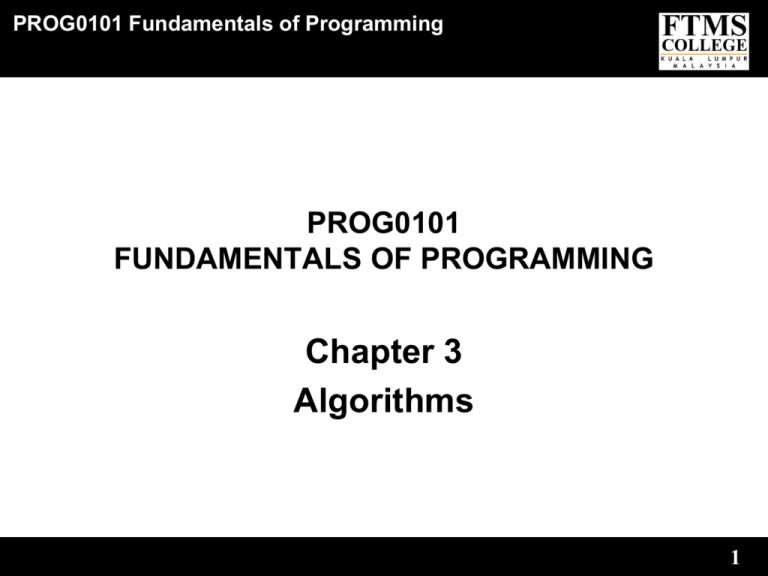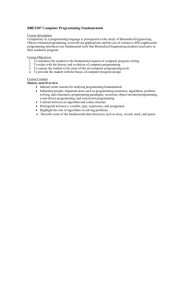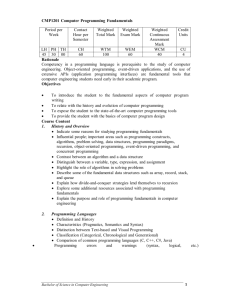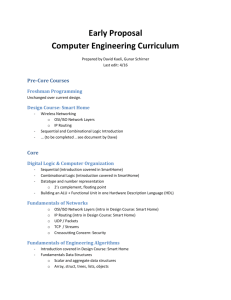Chapter 3 Algorithms
advertisement

PROG0101 Fundamentals of Programming PROG0101 FUNDAMENTALS OF PROGRAMMING Chapter 3 Algorithms 1 PROG0101 Fundamentals of Programming Algorithms Introduction to Algorithms • A sequence of instructions. • A procedure or formula for solving a problem. • It was created mathematician, Mohammed ibn-Musa al-Khwarizmi. • Often used for calculation, data processing and programming. • Algorithms can be expressed in any language. 2 PROG0101 Fundamentals of Programming Algorithms Topics • Algorithms • Pseudocode • Flowcharts 3 PROG0101 Fundamentals of Programming Algorithms Introduction to Algorithms • Algorithms for making things will often be divided into sections; – the parts/components/ingredients (inputs) required to accomplish the task – actions/steps/methods (processing) to produce the required outcome (output). • For example to build a model car, the parts (inputs) are needed plus instructions on how to assemble the car (processing) and the result is the car (output). 4 PROG0101 Fundamentals of Programming Algorithms Introduction to Algorithms • Two forms of Algorithm: – Pseudocode – Flow chart 5 PROG0101 Fundamentals of Programming Algorithms Pseudocode • Pseudocode (which means fake code, because its not really programming code) specifies the steps required to accomplish the task. • Pseudocode is a type of structured English that is used to specify an algorithm. • Pseudocode cannot be compiled nor executed, and there are no real formatting or syntax rules. 6 PROG0101 Fundamentals of Programming Algorithms Pseudocode Example of Pseudocode: Ready and open subscriber file Get a record Do while more records If current subscriber subscription count is > 3 then Output the record Get another record end 7 PROG0101 Fundamentals of Programming Algorithms Advantages of Pseudocode • Reduced complexity. • Increased flexibility. • Ease of understanding. 8 PROG0101 Fundamentals of Programming Algorithms Why is Pseudocode Necessary? • The programming process is a complicated one. • You must first understand the program specifications. • Then you need to organize your thoughts and create the program. • You must break the main tasks that must be accomplished into smaller ones in order to be able to eventually write fully developed code. • Writing Pseudocode will save you time later during the construction & testing phase of a program's development. 9 PROG0101 Fundamentals of Programming Algorithms How to Write Pseudocode Statements? There are six basic computer operations 1. A computer can receive information Read (information from a file) Get (information from the keyboard) 2. A computer can put out information Write (information to a file) Display (information to the screen) 10 PROG0101 Fundamentals of Programming Algorithms How to Write Pseudocode Statements? There are six basic computer operations 3. A computer can perform arithmetic Use actual mathematical symbols or the words for the symbols Example: Add number to total Total = total + number +, -, *, / Calculate, Compute also used 11 PROG0101 Fundamentals of Programming Algorithms How to Write Pseudocode Statements? There are six basic computer operations 4. A computer can assign a value to a piece of data 3 cases i. to give data an initial value Initialize, Set 12 PROG0101 Fundamentals of Programming Algorithms How to Write Pseudocode Statements? There are six basic computer operations 4. A computer can assign a value to a piece of data 3 cases ii. to assign a value as a result of some processing „=‟ *x=5+y 13 PROG0101 Fundamentals of Programming Algorithms How to Write Pseudocode Statements? There are six basic computer operations 4. A computer can assign a value to a piece of data 3 cases iii. to keep a piece of information for later use Save, Store 14 PROG0101 Fundamentals of Programming Algorithms How to Write Pseudocode Statements? There are six basic computer operations 5. A computer can compare two piece of information and select one of two alternative actions IF condition THEN some action ELSE alternative action ENDIF 15 PROG0101 Fundamentals of Programming Algorithms How to Write Pseudocode Statements? There are six basic computer operations 6. A computer can repeat a group of actions WHILE condition (is true) some action ENDWHILE FOR a number of times some action ENDFOR 16 PROG0101 Fundamentals of Programming Algorithms Data Dictionaries • The pseudo code by itself doesn't provide enough information to be able to write program code. • Data Dictionaries are used to describe the data used in the Pseudo Code. • The standard data types used in Pseudo Code are Integer, Double, String, Char and Boolean. 17 PROG0101 Fundamentals of Programming Algorithms Data Dictionaries Name number1 Data Type Integer number2 Integer total Integer Description The first number to be added The second number to be added The total of number1 and number2 added together 18 PROG0101 Fundamentals of Programming Algorithms Example 1: Program Specification: Write a program that obtains two integer numbers from the user. It will print out the sum of those numbers. Pseudocode: Prompt the user to enter the first integer Prompt the user to enter a second integer Compute the sum of the two user inputs Display an output prompt that explains the answer as the sum Display the result 19 PROG0101 Fundamentals of Programming Algorithms Example 2: Finding average of any three numbers. We might usually specify the procedure of solving this problem as “add the three numbers and divide by three”. Here, Read (or Ask) and Write (or Say) are implied. However in an algorithm, these steps have to be made explicit. Thus a possible algorithm is: 20 PROG0101 Fundamentals of Programming Algorithms Example 2: Step 1 Step 2 Step 3 Step 4 Step 5 Step 6 Start Read values of X, Y, Z S=X+Y+Z A=S/3 Write value of A Stop 21 PROG0101 Fundamentals of Programming Algorithms Example 2: Or you can write like this: Step 1 Step 2 Step 3 Step 4 Step 5 Step 6 Start Read values of X, Y, Z S=X+Y+Z A=S/3 Write value of A Stop 22 PROG0101 Fundamentals of Programming Algorithms Example 3: Finding square and cube. Step 1 Step 2 Step 3 Step 4 Step 5 Step 6 Start Read value of N S=N*N C=S*N Write values of S, C Stop 23 PROG0101 Fundamentals of Programming Algorithms Example 4: Finding biggest of two numbers. Step 1 Step 2 Step 3 Step 4 Step 5 Start Read A, B If A > B, then BIG = A, otherwise BIG = B Write BIG Stop 24 PROG0101 Fundamentals of Programming Algorithms Example 5: Calculate pay. Step 1 Step 2 Step 3 Step 4 Step 5 Step 6 Start Input hours Input rate pay = hours * rate Print pay End 25 PROG0101 Fundamentals of Programming Algorithms Exercise: Write a Pseudocode for these problems. 1. 2. S = (A + B + C) / Y Convert from Celsius to Fahrenheit. (Multiply by 9, then divide by 5, then add 32 ) 3. 4. Area of Circle (r2) Volume of Sphere ( 4 r3) 3 5. Average speed = Distance traveled Time taken 26 PROG0101 Fundamentals of Programming Algorithms Flowchart • A flowchart is a graphical representation of an algorithm. • These flowcharts play a vital role in the programming of a problem and are quite helpful in understanding the logic of complicated and lengthy problems. • Once the flowchart is drawn, it becomes easy to write the program in any high level language. 27 PROG0101 Fundamentals of Programming Algorithms Flowchart • A flowchart can therefore be used to: – Define and analyze processes – Build a step-by-step picture of the process for analysis, discussion, or communication – Define, standardize or find areas for improvement in a process 28 PROG0101 Fundamentals of Programming Algorithms Flowchart 29 PROG0101 Fundamentals of Programming Algorithms Flowchart Symbols Start and end symbols • Represented as lozenges, ovals or rounded rectangles • Usually containing the word "Start" or "End", or another phrase signalling the start or end of a process, such as "submit enquiry" or "receive product". 30 PROG0101 Fundamentals of Programming Algorithms Flowchart Symbols Arrows • Showing what's called "flow of control" in computer science. • An arrow coming from one symbol and ending at another symbol. • Represents that control passes to the symbol the arrow points to. 31 PROG0101 Fundamentals of Programming Algorithms Flowchart Symbols Processing steps • Represented as rectangles. • Examples: “Add 1 to X"; "replace identified part"; "save changes" or similar. 32 PROG0101 Fundamentals of Programming Algorithms Flowchart Symbols Input/Output • Represented as a parallelogram. • Examples: Get X from the user; display X. 33 PROG0101 Fundamentals of Programming Algorithms Flowchart Symbols Conditional or decision • Represented as a diamond (rhombus). • These typically contain a Yes/No question or True/False test. 34 PROG0101 Fundamentals of Programming Algorithms Flowchart Symbols Display • Indicates a process flow step where information is displayed to a person (e.g., PC user, machine operator). 35 PROG0101 Fundamentals of Programming Algorithms Rules for Flowchart 1. Every flow chart has a START symbol and a STOP symbol. 2. The flow of sequence is generally from the top of the page to the bottom of the page. This can vary with loops which need to flow back to an entry point. 3. Use arrow-heads on connectors where flow direction may not be obvious. 4. There is only one flow chart per page. 36 PROG0101 Fundamentals of Programming Algorithms Rules for Flowchart 5. A page should have a page number and a title. 6. A flow chart on one page should not break and jump to another page 7. A flow chart should have no more than around 15 symbols (not including START and STOP). 37 PROG0101 Fundamentals of Programming Algorithms Advantages of Using Flowcharts • Communication: Flowcharts are better way of communicating the logic of a system to all concerned. • Effective analysis: With the help of flowchart, problem can be analysed in more effective way. • Proper documentation: Program flowcharts serve as a good program documentation, which is needed for various purposes. • Efficient Coding: The flowcharts act as a guide or blueprint during the systems analysis and program development phase. 38 PROG0101 Fundamentals of Programming Algorithms Advantages of Using Flowcharts • • Proper Debugging: The flowchart helps in debugging process. Efficient Program Maintenance: The maintenance of operating program becomes easy with the help of flowchart. It helps the programmer to put efforts more efficiently on that part. 39 PROG0101 Fundamentals of Programming Algorithms Basic Control Structures • • • Sequence Selection Loop 40 PROG0101 Fundamentals of Programming Algorithms Basic Control Structures Sequence • • Steps that execute in sequence are represented by symbols that follow each other top to bottom or left to right. Top to bottom is the standard. 41 PROG0101 Fundamentals of Programming Algorithms Basic Control Structures Sequence 42 PROG0101 Fundamentals of Programming Algorithms Basic Control Structures Selection • • Once the condition is evaluated, the control flows into one of two paths. Once the conditional execution is finished, the flows rejoin before leaving the structure. 43 PROG0101 Fundamentals of Programming Algorithms Basic Control Structures Selection 44 PROG0101 Fundamentals of Programming Algorithms Basic Control Structures Loop • • Either the processing repeats or the control leaves the structure. Notice that the return line joins the entry line before the question. 45 PROG0101 Fundamentals of Programming Algorithms Basic Control Structures Loop 46 PROG0101 Fundamentals of Programming Algorithms Example 1: Algorithm: Input: two numbers x and y Output: the average of x and y Steps: 1. input x 2. input y 3. sum = x + y 4. average = sum /2 5. output average 47 PROG0101 Fundamentals of Programming Algorithms Example 1: 48 PROG0101 Fundamentals of Programming Algorithms Example 2: Draw a flowchart to find the largest of three numbers A, B, and C. 49 PROG0101 Fundamentals of Programming Algorithms Example 2: 50






